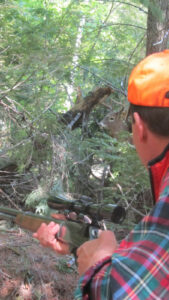Buck Fever

BY Tom Kelly
We have all heard the term, “Buck Fever”. Most of us have at one time or another even experienced it. This malady doesn’t just afflict deer hunters. In fact, I have frequently seen experienced deer hunters become victims of target panic when they see their first bear in the woods sneaking into a bait. My personal experience with this virus was on a handgun elk hunt in Idaho.
The guide was cow calling about 20 yards behind me. I was looking straight ahead toward the location of the last bugle. Suddenly, a massive bull elk came charging through a spruce tree 12 yards to my left bugling and blowing snot. I came unglued! I nearly fell down in an attempt to pivot and face the bull. He was much more agile and escaped into cover before I could regain my composure. To say I was shaken would be an understatement. Fortunately, my excellent guide was able to provide redemption with another bull later in the week.
Second Chances
Unfortunately, second chances are not always available. So rather than depend on second chances, what are some preventive steps we can take to avoid buck fever or target panic? Well, if we didn’t care so much about getting that big buck or knocking that big bear down, we would not succumb to the fever. So, don’t care so much. Who cares if you make that shot. It’s not a big deal. Ya, that’s not going to happen. You need to become totally familiar and comfortable with your chosen hunting arm. We need to know every detail of that gun or bow. We need to have total confidence in its accuracy and performance. To do this, we need to practice and have confidence in our own abilities as well.
Practice
Further, when we practice, we must practice in the manner in which we will hunt. We need confidence in shooting at the ranges we will be shooting in the field. We also need to shoot off-hand if that’s how we hunt. Shoot sitting if that is how you hunt. If you hunt with a rest, that’s how you should practice. If you are going on a guided hunt, talk to your guide to determine how you will be shooting, including the average ranges. Fumbling and surprises are big contributors to the fever. Bow hunters have long recognized the value of a shot release routine. Firearms hunters should create their own shot release routine or sequence of action. This sequence should be practiced relentlessly, including verbalizing the routine over and over as you practice. It should go something like this:
- Find your target (aim small, miss small)
- Steady your stance
- Remove safety
- Take a breath
- Visualize shot
- Squeeze trigger(slowly release half of your breath)
- Maintain target picture
Repeat this sequence each time you practice and practice a lot. These are proactive steps that can help deal with all that adrenaline coursing through your veins. The other steps that we should all take are to learn the anatomy of our prey. The best shot placement on all big game animals is not the same. Do your research. Good old Uncle Zeke may not be giving you the best info when he says “shoot em in the neck”. Confidence in the firearm we are shooting also means that we know it will function. It also means using enough gun.
Enough Gun
Many of the facebook gun experts would have you believe that you can kill a moose with a .223. Yes, it is possible. That doesn’t mean it’s a good idea. It’s also possible for Pee Wee Herman to beat Mike Tyson in a fight. It’s just not a good idea for Pee Wee Herman to find out. Using a caliber that is designed for the task that you have at hand, that you shoot well, with the correct ammo, will give you enormous confidence in your battle against buck fever.
In all of these preparations, take a kid or new hunter with you. It’s good for all of us.
For more stories about hunting, fishing and the great outdoors, be sure to subscribe to the Northwoods Sporting Journal.
